(date: 2024-08-17 22:51:46)
date: 2024-08-16, from: NOAA tornado/severe thunderstorm watches, mesoscale discussions, convective outlooks, fire weather outlooks

STATUS REPORT ON WW 627 THE SEVERE WEATHER THREAT CONTINUES ACROSS THE ENTIRE WATCH AREA. ..THORNTON..08/16/24 ATTN...WFO...DDC...ICT... STATUS REPORT FOR WS 627 SEVERE WEATHER THREAT CONTINUES FOR THE FOLLOWING AREAS KSC007-009-015-025-033-035-047-077-079-095-097-113-145-151-155- 159-173-185-191-161840- KS . KANSAS COUNTIES INCLUDED ARE BARBER BARTON BUTLER CLARK COMANCHE COWLEY EDWARDS HARPER HARVEY KINGMAN KIOWA MCPHERSON PAWNEE PRATT RENO RICE SEDGWICK STAFFORD SUMNER THE WATCH STATUS MESSAGE IS FOR GUIDANCE PURPOSES ONLY. PLEASE REFER TO WATCH COUNTY NOTIFICATION STATEMENTS FOR OFFICIAL INFORMATION ON COUNTIES...INDEPENDENT CITIES AND MARINE ZONES CLEARED FROM SEVERE THUNDERSTORM AND TORNADO WATCHES.
https://www.spc.noaa.gov/products/watch/ws0627.html
date: 2024-08-16, from: NOAA tornado/severe thunderstorm watches, mesoscale discussions, convective outlooks, fire weather outlooks

URGENT - IMMEDIATE BROADCAST REQUESTED
Severe Thunderstorm Watch Number 627
NWS Storm Prediction Center Norman OK
1055 AM CDT Fri Aug 16 2024
The NWS Storm Prediction Center has issued a
* Severe Thunderstorm Watch for portions of
Southwest and south central Kansas
* Effective this Friday morning and afternoon from 1055 AM until
400 PM CDT.
* Primary threats include...
Scattered large hail and isolated very large hail events to 2.5
inches in diameter likely
Scattered damaging winds likely with isolated significant gusts
to 75 mph possible
SUMMARY...Elevated supercells may persist into the afternoon and
become rooted at the surface while moving southeastward. The more
intense storms will be capable of producing hail up to 2.5 inches in
diameter and severe outflow gusts up to 75 mph.
The severe thunderstorm watch area is approximately along and 55
statute miles north and south of a line from 15 miles west of Dodge
City KS to 20 miles east northeast of Wichita KS. For a complete
depiction of the watch see the associated watch outline update
(WOUS64 KWNS WOU7).
PRECAUTIONARY/PREPAREDNESS ACTIONS...
REMEMBER...A Severe Thunderstorm Watch means conditions are
favorable for severe thunderstorms in and close to the watch area.
Persons in these areas should be on the lookout for threatening
weather conditions and listen for later statements and possible
warnings. Severe thunderstorms can and occasionally do produce
tornadoes.
&&
AVIATION...A few severe thunderstorms with hail surface and aloft to
2.5 inches. Extreme turbulence and surface wind gusts to 65 knots. A
few cumulonimbi with maximum tops to 550. Mean storm motion vector
30030.
...Thompson
https://www.spc.noaa.gov/products/watch/ww0627.html
date: 2024-08-16, from: NOAA tornado/severe thunderstorm watches, mesoscale discussions, convective outlooks, fire weather outlooks
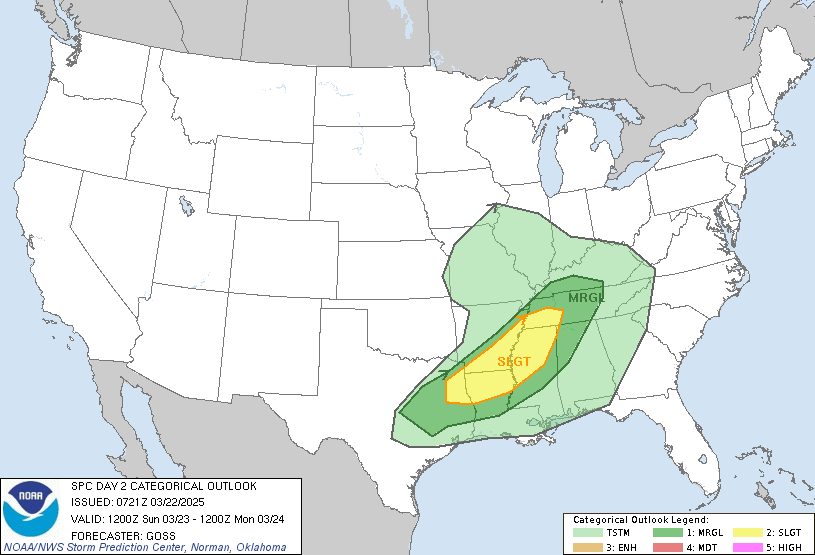
Day 2 Convective Outlook NWS Storm Prediction Center Norman OK 1229 PM CDT Fri Aug 16 2024 Valid 171200Z - 181200Z ...THERE IS A SLIGHT RISK OF SEVERE THUNDERSTORMS IN PARTS OF KY/OH VALLEY AND THE PACIFIC NORTHWEST... ...SUMMARY... Scattered severe thunderstorms are possible in parts of Kentucky and the Ohio Valley on Saturday afternoon through about dusk. Damaging winds and hail are the primary threats. Isolated to scattered severe wind and hail are also possible across parts of western Oregon into southwest Washington on Saturday afternoon through about dusk. ...Lower Great Lakes to the Mid/Deep South... A slow-moving mid/upper trough should continue east across the Great Lakes through early Sunday. An occluded surface cyclone over Lower MI should drift into Lake Huron. A weak cold front will arc to the south-southwest over the Upper OH Valley and trail southwest to west across the Mid-South into OK. Along this baroclinic zone, ongoing convection at 12Z Saturday appears most probable over the Ozarks vicinity. It is plausible this activity may intensify as downstream diurnal destabilization occurs in the Mid to Deep South. Within the mid-level flow gradient, semi-organized clusters are possible with a threat for sporadic damaging winds. The belt of seasonably strong mid to upper-level westerlies should be centered across KY/TN within the basal portion of the Great Lakes trough. Consensus of guidance suggests 700-mb westerlies will be stronger relative to Friday, likely centered on the OH Valley region. With the more prominent diurnal destabilization occurring across KY into the OH Valley, away from the influence of Ozarks to Deep South earlier-day convection, this setup may yield a greater concentration of damaging winds and some severe hail along this portion of the front. Despite the predominately westerly flow regime, deep-layer speed shear should support a mix of multicell clusters and semi-discrete, transient supercell structures. Multiple convective rounds are possible during the afternoon into the early to mid evening. ...Pacific Northwest... A vigorous shortwave impulse, embedded within a broader mid/upper trough, should move inland across northern CA into western OR. This feature may take on a negative-tilt, with pronounced mid-level height falls favorably timed to peak diurnal heating. A strengthening mid to upper jetlet will overspread this region with mid-level winds backing to the south-southeast. Within the exit region of this meridional flow regime, scattered to numerous late-afternoon and evening thunderstorms should be focused from south to north across the Cascade Range. While buoyancy should remain weak, steep mid to low-level lapse rates should support a few supercells capable of both severe hail and wind. The wind threat may be relatively greater across parts of the Columbia Valley near the OR/WA border area as storms cluster into the early evening. ...Eastern Great Basin... A plume of richer 700-mb moisture will advect north from AZ, with peripheral flow enhancement from the West Coast shortwave trough. Guidance is fairly consistent that late morning to midday thunderstorm activity will increase as diurnal destabilization ensues. While this may not be favorably timed with peak heating, the steep lapse-rate environment and moderate deep-layer flow suggest a threat for strong to sporadic severe gusts and small hail. A later round of late afternoon to early evening thunderstorms may occur along the western periphery of this earlier day activity, with a similar threat for low-probability severe. ...Central and northern High Plains... Mid-level ridging is expected across this region between the Great Lakes and West Coast trough, but with moderate mid to upper-level westerlies. Very isolated thunderstorms are possible during the late afternoon to early evening along portions of a lee surface trough. These appear most probable along the northwest periphery of the central Great Plains to Ozarks buoyancy plume, in vicinity of northwest KS, and separately near the Canadian border as a minor shortwave impulse crests the ridge in the southern Prairie Provinces. Deep-layer shear will be adequate for a couple supercells capable of very isolated severe hail and wind. ..Grams.. 08/16/2024
https://www.spc.noaa.gov/products/outlook/day2otlk_1730.html
date: 2024-08-16, from: NOAA tornado/severe thunderstorm watches, mesoscale discussions, convective outlooks, fire weather outlooks
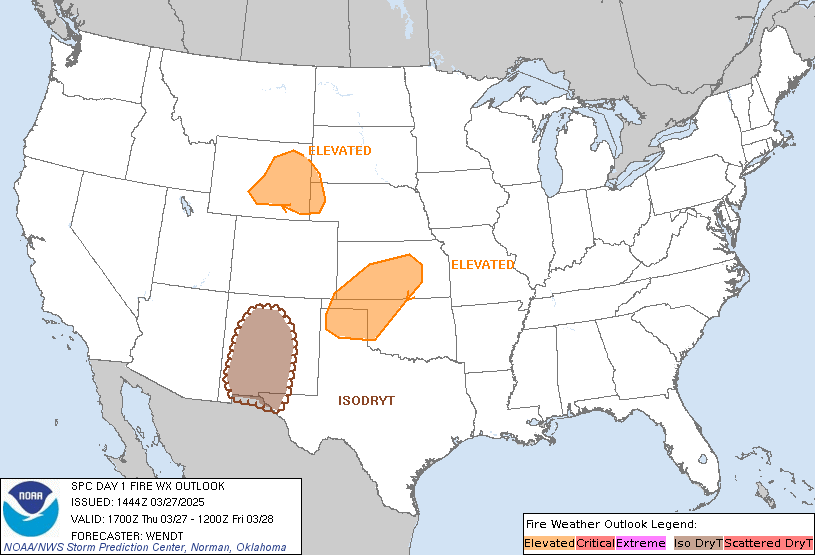
Day 1 Fire Weather Outlook NWS Storm Prediction Center Norman OK 1154 AM CDT Fri Aug 16 2024 Valid 161700Z - 171200Z ...Update... In addition to the potential for isolated dry thunderstorms across WY and MT, isolated dry lightning strikes may also occur over central and southern NM this afternoon and evening. The latest forecast soundings suggest a deeply mixed boundary layer will be in place under a shallow plume of mid-level moisture within an upper-level ridge, and orographic ascent should result in at least isolated moist convection developing with daytime heating. Although widespread fuels are not overly receptive across this region due to recent rainfall, pockets of seasonably high ERCs persist. For the rest of the CONUS, the previous forecast remains accurate and unchanged. Please see the past discussion below for additional details pertaining to NV and CA. ..Barnes.. 08/16/2024 .PREV DISCUSSION... /ISSUED 0103 AM CDT Fri Aug 16 2024/ ...Synopsis... Broad, west-southwesterly mid-level flow will overspread portions of California and northern Nevada today, with a modest jet streak (with 40-45 kt winds) progressing east across the northern Great Basin. As this weak jet moves east, elevated fire-weather conditions are expected across portions of California and Nevada. ...Dry/Windy... South of this mid-level jet and north of a mid-level ridge centered over portions of Arizona and New Mexico, deep boundary layer mixing will result in dry and windy conditions across portions of California, Nevada, and Utah. Surface winds of 20-25 MPH and relative humidity values of 5-10% are expected, though will only overlap narrowly with a belt of receptive fuels across portions of Nevada and California. With winds and relative humidity being supportive of wildfire spread, but only modest fuel receptiveness, highlights have been limited to elevated conditions at this time. Recent wetting rainfall in eastern Nevada and western Utah will limit wildfire potential in these areas, though additional drying of fuels is expected given the dry/windy conditions. ...Dry Thunderstorms... The potential for some dry thunderstorms exists across portions of northern Wyoming and southeastern Montana. However, recent wetting rainfall and fuels guidance suggests there is minimal risk for wildfire spread and lightning-based ignitions at this time. ...Please see www.spc.noaa.gov/fire for graphic product...
https://www.spc.noaa.gov/products/fire_wx/fwdy1.html
date: 2024-08-16, from: NOAA tornado/severe thunderstorm watches, mesoscale discussions, convective outlooks, fire weather outlooks

Day 1 Convective Outlook NWS Storm Prediction Center Norman OK 1126 AM CDT Fri Aug 16 2024 Valid 161630Z - 171200Z ...THERE IS A SLIGHT RISK OF SEVERE THUNDERSTORMS THIS AFTERNOON INTO EARLY TONIGHT FOR SOUTHERN KS...NORTHERN OK AND NORTHWEST AR... ...SUMMARY... Scattered severe thunderstorms are possible for central/southern Kansas into northern Oklahoma and into northwest Arkansas. Very large hail up to 2.5 inches in diameter and severe gusts up to 75 mph are the expected hazards with the stronger thunderstorms. ...KS into OK through tonight... Elevated thunderstorms have formed/strengthened since 14-15z from west central into southwest KS in a zone of low-midlevel warm advection downstream from an embedded speed max aloft. There is still some uncertainty regarding the longevity of these morning storms. However, if the ongoing storms persist into early-mid afternoon when surface temperatures warm into the 90s F, convective inhibition will diminish and the storms will become fully rooted at the surface. Given the conditionally favorable thermodynamic (MLCAPE >2000 J/kg) and vertical shear (effective bulk shear in excess of 40 kt) environment expected across southern KS/northern OK by this afternoon, will maintain the SLGT risk for large hail up to 2.5 inches in diameter and severe outflow gusts up to 75 mph. ...TN/OH Valleys this afternoon/evening... A closed midlevel low will move generally eastward over WI/MI through Saturday morning, as embedded perturbations rotate around the southern periphery of the low. Elevated convection has been slowly weakening through the morning across KY/southern OH, with other storms located farther southwest into western TN. This convection farther south will have more direct access to the moist/unstable warm sector, and there will be some potential for an increase in both storm coverage and intensity this afternoon from middle/eastern TN into northern AL/northwest GA. Occasional downbursts with wind damage will be the main concern with multicell clusters, given the relatively weak deep-layer flow/shear. ...WI to Lower MI this afternoon into early tonight... Scattered thunderstorms are expected to form across WI this afternoon and spread eastward into early tonight, along and ahead of a surface cold front, and in advance of the midlevel closed low. Moisture/buoyancy will be sufficient for strong storms capable of producing isolated large hail near 1 inch and isolated wind damage, but modest vertical shear suggests primarily multicell storms. ..Thompson/Thornton.. 08/16/2024
https://www.spc.noaa.gov/products/outlook/day1otlk_1630.html
date: 2024-08-15, from: NOAA tornado/severe thunderstorm watches, mesoscale discussions, convective outlooks, fire weather outlooks

Day 1 Convective Outlook NWS Storm Prediction Center Norman OK 0743 AM CDT Thu Aug 15 2024 Valid 151300Z - 161200Z ...THERE IS A SLIGHT RISK OF SEVERE THUNDERSTORMS FOR PORTIONS OF THE OZARKS...LOWER MISSOURI VALLEY...AND ILLINOIS... ...SUMMARY... Scattered severe thunderstorms are possible across parts of the Midwest through tonight. Severe gusts capable of wind damage and large hail are the primary risks with the stronger thunderstorms. ...Central Plains to the Mid Mississippi Valley... Morning water-vapor imagery shows a series of embedded disturbances rotating through a larger-scale trough centered over the northern Great Plains. A notable shortwave trough is located near the WY/NE/SD vicinity and this feature will move east reaching the Upper Great Lakes by Friday morning. A lead convectively augmented disturbance is moving east across the mid MS Valley this morning, and it will move east into the southern Great Lakes and weaken during the day. Broken bands of showers/thunderstorms associated with this lead impulse will progress east this morning and move into a less unstable airmass across the Wabash Valley. Some rejuvenation of storms is possible later today on the southern portion of the trailing outflow near the MS-OH River confluence westward into the Ozarks. Appreciable uncertainty exists at this time on the intensity/coverage of storms in the aforementioned corridor. Nonetheless, heating of a moist airmass will potentially yield an environment favorable for at least isolated to widely scattered storms capable of a wind/hail threat. In wake of the early day cloud debris and overnight storm activity, strong boundary-layer heating is expected across much of the Plains into portions of the mid MS Valley. As a result, strong buoyancy will develop along the eastern edge of this steeper lapse-rate plume. Model guidance suggests very strong instability (MLCAPE >3000 J/kg) will probably develop by mid-late afternoon from portions of eastern KS/MO into southern IA. Thunderstorms may focus along a synoptic front that will arc from southeast MN-eastern IA-northern MO-southeast KS-northern OK by late afternoon. Some guidance (i.e., 00Z MPAS and recent HRRR runs) indicates lower storm coverage until later this evening across the lower MO Valley/mid MS Valley portion of the Slight Risk. Regardless, deep-layer shear should be adequate for supercells and organized clusters and wind/hail can be expected with the most robust updrafts. High-based thunderstorms are also expected to develop along the trailing boundary into the southern Plains where surface temperatures will easily rise through the upper 90s to near 100F. The stronger evaporatively cooled downdrafts will potentially result in severe gusts before this activity diminishes by mid-late evening. ...New England... Upper troughing will hold across New England today with cool mid-level temperatures and modest northerly flow at 500mb. Strong boundary-layer heating will allow convective temperatures to be breached by 19z and scattered convection is expected to develop within a sheared environment that favors robust multi-cell updrafts. Some of this activity could generate strong gusts and marginally severe hail. Convection will be diurnally driven and should weaken with loss of daytime heating. ...Northern Rockies... A mid- to upper-level trough over the Pacific Northwest will gradually move northeast impinging on the northern Rockies by afternoon. The favorable timing of large-scale ascent and diurnal destabilization will yield scattered to numerous thunderstorms developing from the Upper Snake Valley north-northwestward into north-central ID and western MT by early evening. Forecast soundings show steep lapse rates and potentially favorable for localized severe gusts with the stronger thunderstorm cores and outflow-dominant clusters. ..Smith.. 08/15/2024
https://www.spc.noaa.gov/products/outlook/day1otlk_1300.html
date: 2024-08-14, from: NOAA Weather Forecasts
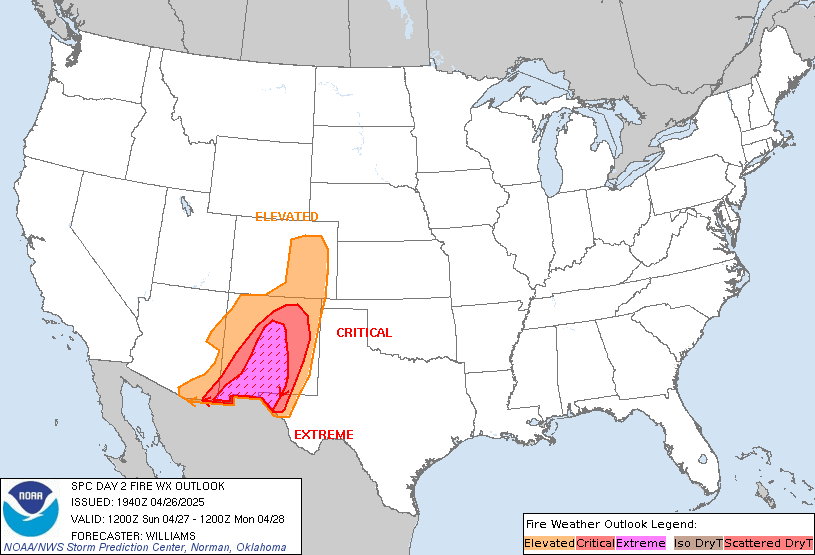
Day 2 Fire Weather Outlook NWS Storm Prediction Center Norman OK 0150 AM CDT Wed Aug 14 2024 Valid 151200Z - 161200Z ...Synopsis... A mid-level shortwave trough is forecast to cross the northern California coast early Thursday morning and deepen over western Oregon during the afternoon hours, bringing with it multiple rounds of isolated dry thunderstorms across central and eastern Oregon. ...Dry Thunderstorms... Some dry thunderstorms are expected to be ongoing at the start of the period Thursday morning. However, the greatest likelihood for thunderstorms will be in the afternoon and early evening hours, where a mix of scattered wet/dry thunderstorms are forecast across central and eastern Oregon. Even though fuels are near or at the 90th annual percentile over much of Oregon, the mix of wet/dry thunderstorms and relatively slow storm motions should result in at least some wetting rainfall limiting the overall threat despite scattered storm coverage. ...Dry/Windy... Surface winds are expected to remain below Elevated fire-weather criteria, except for where diurnally and terrain-driven winds are locally maximized. Given the localized nature of the better surface winds, no highlights are expected at this time. ..Halbert/Wendt.. 08/14/2024 ...Please see www.spc.noaa.gov/fire for graphic product...
https://www.spc.noaa.gov/products/fire_wx/fwdy2.html
date: 2024-08-12, from: NOAA tornado/severe thunderstorm watches, mesoscale discussions, convective outlooks, fire weather outlooks

Mesoscale Discussion 1889
NWS Storm Prediction Center Norman OK
0634 PM CDT Mon Aug 12 2024
Areas affected...Northeastern Colorado
Concerning...Severe potential...Watch unlikely
Valid 122334Z - 130100Z
Probability of Watch Issuance...5 percent
SUMMARY...A supercell thunderstorm capable of damaging winds, hail,
and perhaps a tornado is tracking southward across portions of
northeast Colorado. Given the isolated nature of this storm, weather
watch issuance is not likely.
DISCUSSION...The severe weather threat associated with a
southward-moving supercell in northeast Colorado may persist for the
next 1-2 hours. The storm has exhibited signs of prolonged low-level
rotation, has produced 2.00 inch hail, and is moving into an
environment that will continue to support updraft rotation. Forecast
proximity hodographs indicate there is sufficient curvature of the
low-level flow and streamwise vorticity to support continued
low-level mesocyclone development and cycling. Both the curvature
and magnitude of the low-level hodograph is expected to increase as
the nocturnal low-level jet strengthens with the decoupling of the
boundary-layer. However, recent radar trends suggest the storm is
struggling to stay ahead of its own outflow, where temperatures are
15-20 F cooler than unmodified inflow. This supercell will likely
undergo several phases of organized low-level rotation, followed by
surging outflow, until the boundary-layer eventually stabilizes this
evening and convection becomes more elevated in nature.
..Halbert/Wendt/Edwards.. 08/12/2024
...Please see www.spc.noaa.gov for graphic product...
ATTN...WFO...BOU...
LAT...LON 40790427 40960414 40980387 40870363 40680344 40460333
40260326 40120319 39920338 39830370 39860389 40000414
40140421 40330425 40510427 40790427
https://www.spc.noaa.gov/products/md/md1889.html
date: 2024-08-12, from: NOAA tornado/severe thunderstorm watches, mesoscale discussions, convective outlooks, fire weather outlooks
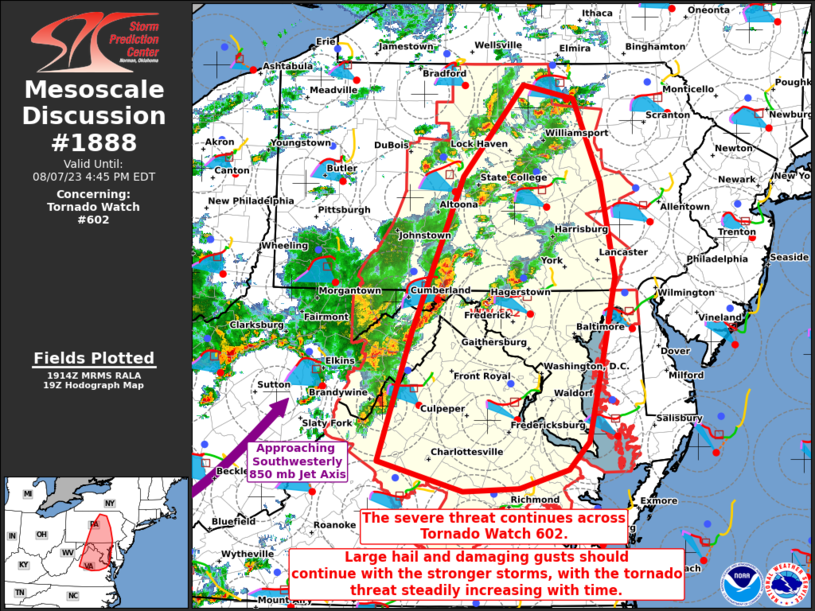
Mesoscale Discussion 1888
NWS Storm Prediction Center Norman OK
0513 PM CDT Mon Aug 12 2024
Areas affected...North-central Montana
Concerning...Severe potential...Watch unlikely
Valid 122213Z - 130015Z
Probability of Watch Issuance...5 percent
SUMMARY...A potential will exist for marginally severe gusts and
hail early this evening across parts of north-central Montana. No
watch issuance is anticipated.
DISCUSSION...The latest water-vapor imagery shows a subtle shortwave
trough over the northern Rockies, embedded in southwest mid-level
flow. At the surface, a mesolow is analyzed over north-central
Montana, with upslope east-southeasterly flow located across much of
northern and eastern Montana. Isolated thunderstorms have developed
near and to the north of the low along a narrow corridor of
instability, where the RAP is estimating SBCAPE in the 1000 to 1500
J/kg range. Short-term forecast soundings in north-central Montana
early this evening have a relatively dry boundary layer, but show
steep lapse rates and moderate deep-layer shear. This may be enough
for a marginal severe threat for a few hours. Strong gusts and hail
will be possible.
..Broyles/Edwards.. 08/12/2024
...Please see www.spc.noaa.gov for graphic product...
ATTN...WFO...GGW...TFX...
LAT...LON 47221015 47150938 47340862 47740811 48320827 48880909
48961048 48861165 48541205 48011188 47221015
https://www.spc.noaa.gov/products/md/md1888.html
date: 2024-08-12, from: NOAA tornado/severe thunderstorm watches, mesoscale discussions, convective outlooks, fire weather outlooks
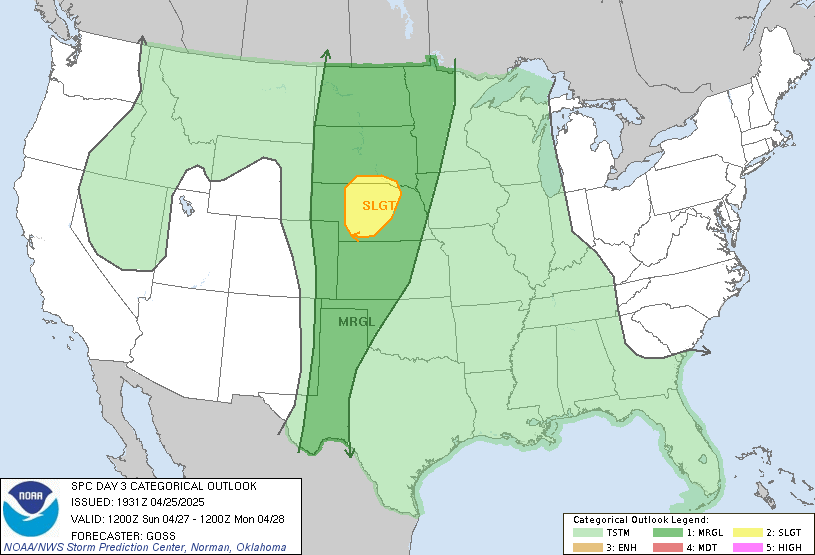
Day 3 Convective Outlook NWS Storm Prediction Center Norman OK 0218 PM CDT Mon Aug 12 2024 Valid 141200Z - 151200Z ...THERE IS A MARGINAL RISK OF SEVERE THUNDERSTORMS ACROSS PORTIONS OF THE CENTRAL/NORTHERN PLAINS INTO THE MID-MISSOURI VALLEY... ...SUMMARY... At least isolated severe thunderstorms may occur Wednesday across parts of the northern/central Plains into the mid Missouri Valley. ...Synopsis... A band of elevated thunderstorms will likely be ongoing at the beginning of the period across a broad region of isentropic ascent from southeast South Dakota to southern Missouri. As the low-level jet weakens through the morning, expect the intensity of these storms to lessen as they move east into a more stable airmass. To the west, an unstable airmass is forecast across much of the central and northern Plains in the vicinity of a broad surface trough. At least weak to moderate instability is forecast with the potential for greater instability in eastern NE/KS where higher dewpoints (upper 60s to low 70s) are forecast. The breakdown of the upper-level ridge will lead to height falls across much of the central and northern Plains. Given the unstable environment across much of the area, this weak upper-level forcing combined with the surface trough will likely result in scattered thunderstorms across much of the central and northern Plains Wednesday afternoon/evening. A more focused threat may exist farther south across eastern Kansas in Nebraska. Some enhancement of the mid-level flow ahead of the ridge breakdown may lead to a localized region of more favorable wind shear, co-located with the forecast greater instability. If this occurs, particularly with the development of a surface low as forecast by the NAM/ECMWF, a locally greater severe weather threat may occur across this region. At this time, uncertainty in the mesoscale features which will impact this potential are too great to warrant higher severe weather probabilities. ..Bentley.. 08/12/2024
https://www.spc.noaa.gov/products/outlook/day3otlk_1930.html
date: 2024-08-12, from: NOAA tornado/severe thunderstorm watches, mesoscale discussions, convective outlooks, fire weather outlooks

Day 1 Convective Outlook NWS Storm Prediction Center Norman OK 0300 PM CDT Mon Aug 12 2024 Valid 122000Z - 131200Z ...THERE IS A MARGINAL RISK OF SEVERE THUNDERSTORMS ACROSS THE COASTAL CAROLINAS...CENTRAL HIGH PLAINS...EASTERN GREAT BASIN NORTHWARD INTO PARTS OF THE NORTH-CENTRAL ROCKIES...AND NORTHERN MONTANA... ...SUMMARY... Isolated severe thunderstorms are possible today over parts of the coastal Carolinas, central High Plains, the eastern Great Basin northward into parts of the north-central Rockies, and northern Montana. ...20z Update... No changes are needed to the Day 1 Outlook. Marginal risk for strong to severe gusts and large hail will continue through the afternoon across the central High Plains/Central Plains as well as the Intermountain West into the northern High Plains. See MCD#1186 and MCD#1885 for more information. Additional thunderstorm development is expected across a front portions of South Carolina this afternoon. Ahead of this boundary, the air mass has destabilized, with around 2000 J/kg of MLCAPE and 20-30 kts of deep layer shear. Thunderstorms will be capable of instances of strong to severe wind. ..Thornton/Mosier.. 08/12/2024 .PREV DISCUSSION... /ISSUED 1129 AM CDT Mon Aug 12 2024/ ...Central High Plains/Central Plains... Upslope flow will persist across the central High Plains, helping to maintain moderate low-level moisture across region. Afternoon dewpoints are expected to range from the upper 60s in the southeast CO/northeast NM/western Panhandles vicinity to the mid to upper 50s across eastern WY. This low-level moisture will help support moderate buoyancy during the afternoon/evening, although some limited capping may linger. Thunderstorms are expected to develop across the higher terrain before then progressing eastward into the more moist and buoyant airmass downstream. Generally moderate deep-layer vertical shear coupled with the potential for some remaining convective inhibition suggest the severe potential will remain isolated, with damaging gusts and/or large hail as the primary severe risks. Thunderstorms will likely persist eastward into more of the central Plains, supported by moderate buoyancy and shear and the development of modest low-level jet. Isolated instances of large hail are possible, but the overall storm severity will likely be tempered by limited instability. ...Intermountain West into the Northern High Plains... Morning satellite imagery depicts upper ridging centered over TX covering much of the southern third of the CONUS and also extending northward into MT. Several shortwave troughs are moving through the westerlies within the northern periphery of this ridging, including a low-amplitude shortwave currently moving into ID and northern/central NV and another, more defined shortwave farther west off the northern CA coast. Eastward/northeastward progression of these waves will bring greater mid-level moisture and increased large-scale forcing for ascent, supporting the development of scattered to numerous thunderstorms across the region. Mid-level flow will remain modest, but a few more organized/persistent updrafts are possible. High cloud bases atop steep low-level lapse rates could result in a few stronger gusts as these more persistent storms form into clusters, particularly from northern/central UT into far eastern ID and far western WY and northern MT. ...Coastal Carolinas... Far southern periphery of an upper trough currently extending from Quebec through the Upper OH Valley will glance this region today as it progresses eastward. Modest (i.e. 20-30kt) mid-level flow will overspread a moisture-rich airmass (i.e. PWs over 2") in place south of a front. Scattered thunderstorms should develop along this boundary by early afternoon then propagate toward and off the coast by early evening. A few water-loaded downbursts capable of damaging gusts could be noted with the strongest storms.
https://www.spc.noaa.gov/products/outlook/day1otlk_2000.html